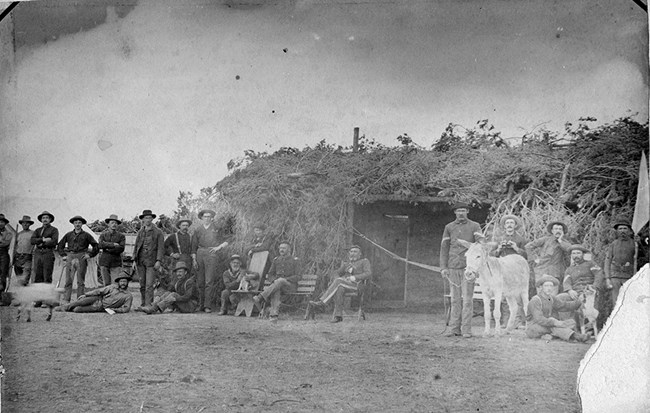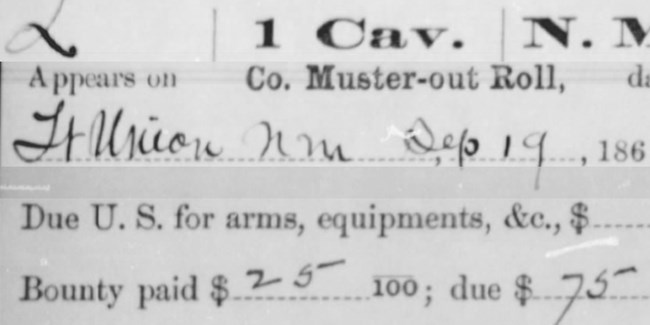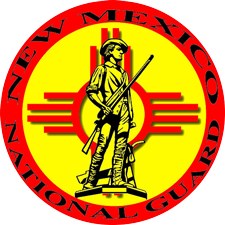|
When the Civil War erupted, the army needed as many as soldiers as possible in Virginia and in other eastern locations. As the army was shifting troops from its western forts to the East, it got an unpleasant surprise: The Confederates were preparing to invade New Mexico. Faced with a pressing need for more soldiers in New Mexico, the army turned for help to the local Hispano population. Recruiting and training nuevo mexicanos provided new challenges for the army. Save the Union?The classic rallying cry for Union recruiters--Save the Union!--fell on deaf ears in New Mexico. Long ruled by Spain and then Mexico, New Mexico had only been a U.S. territory for a mere 12 years. Most of the inhabitants spoke Spanish, not English. There were no memories of fathers who had fought against the dreaded British Redcoats. Instead, recruiters in New Mexico turned to a more local matter--long-standing hostility to and border disputes with Texas. The new recruiting refrain was more like: "The Texans are coming back to take your land!" It worked. (Even after the war ended, many locals referred to the Civil War as "la guerra contra les Tejanos.") By the end of 1861, 3,500 local Hispanos had enlisted in the U.S. Army, many of them mustering in at Fort Union. Now, the army faced the daunting task of training non-English speaking recruits in military discipline, marching and close-order drill. At the same time, the recruits at Fort Union were working day and night to build a new fort. Meanwhile, the new recruits worried about their families. In some cases, family members camped out around Fort Union while husbands and fathers drilled. The regular Army officers, all Anglos from the eastern United States, were in many cases prejudiced against the Hispano recruits, demeaning their ability, work ethic and courage. With the help of bi-lingual junior officers and recruiting efforts by locally prominent Hispanos, the army managed to assemble a substantial fighting force by winter 1862. The new recruits finished building the new Fort Union within a year. In February 1862, with the Confederate invasion under way in earnest, all five regiments of New Mexico Volunteers were sent to Fort Craig, south of Socorro. 
New Mexico Highlands University--Arrott Collection Meeting the ElephantThe New Mexico Volunteers' first major military encounter--"meeting the elephant," in Civil War parlance--took place at the Battle of Valverde, just south of Socorro, New Mexico. After the Federals retreated into nearby Fort Craig, there were conflicting accounts of the performance by the New Mexicans. Anglo Army officers pooh-poohed their efforts. But Col. Christopher "Kit" Carson, commanding the 1st New Mexico Volunteers at the battle, vouched for their service. "After advancing some 400 yards, we found a large body (some 400 or 500) of the enemy charging diagonally across our front," said Carson's report of the battle. "As the head of the enemy's column came within some 80 yards of my right, a volley from the whole column was poured into them, and the firing being kept up caused them to break in every direction and retreat." Within six weeks, some of the New Mexico Volunteers were back in combat--at the battle of Glorieta Pass. With the loss of their supplies at Glorieta, the Confederates began a slow retreat back to Texas, harrassed by the New Mexico Volunteers as they marched south. Fearing another Confederate invasion, the Union Army kept patrolling the Canadian and Pecos River valleys. The Hispanic soldiers served prominently as undercover operatives for the army (known as "spies and guides" at the time) because they blended in easily with the local population. Once the threat of Confederate invasion passed (by the end of 1862), the New Mexico Volunteers completed their enlistments fighting Indians, patrolling the Santa Fe Trail and in the 1863-64 campaign against the Navajo tribe. 
Paymasters and PeonsGetting paid was a challenge for all soldiers serving in the western frontier forts. It was especially pressing for the New Mexico Volunteers, many of whom had left families at home. When the army payroll was severely delayed in the winter of 1862, there was a rash of desertions from the New Mexico Volunteers. For many of the volunteers, there was strong financial incentive to complete their three-year enlistmets. The army offered a $100 bonus (known as a bounty) for joining up, which represented almost a year's pay of $13 per month. But $75 of the bounty was withheld until the recruit finished the entire three years. The army faced yet another issue: the local New Mexico institution of peonage. Peons were virtual slaves. They were laborers who owed virtually insurmountable debts to wealthy landowners and were obligated to work for the landowners until the debt was paid off. Recruiting officers paid no heed to the institution of peonage, recruiting peons as if they were free men. Despite complaints from the landowners, many peons enlisted in the Army. (The U.S. Congress abolished New Mexico peonage in 1867.) 
"Their Courage is Unquestionable"By the end of the Civil War, some 4,000 troops had served the U.S. Army as New Mexico Volunteers. Despite a tradition of prejudice within the Anglo ranks of the army, the New Mexico volunteers served with credit. "They are more energetic and untiring in pursuit, enduring a large amount of physical fatigue," observed Col. Christopher "Kit" Carson. "And when well officered, their courage is unquestionable." The last of the New Mexico Volunteers were discharged in 1867. They were succeeded by the New Mexico Territorial Militia, which, in 1897, became the New Mexico National Guard. In many cases, descendants of the New Mexico Volunteers, are still living in the local area. Fort Union National Monument has an excellent database of New Mexco troops, including their service records. Descendants interested in researching the Civil War service of their kin should contace the park at 505-425-8025, ext. 0 or email us. |
Last updated: January 29, 2021
